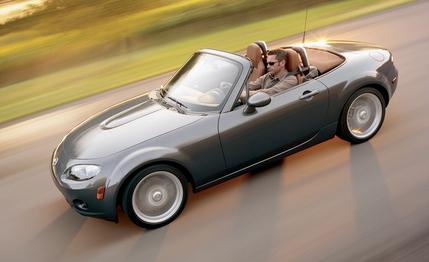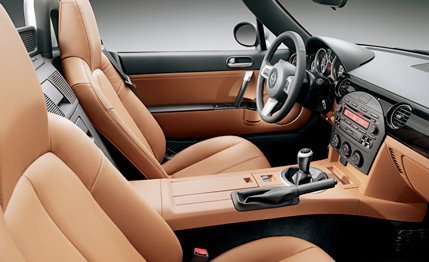
 First Drive Review
First Drive Review


No one asked Mazda two decades ago to reinvent the roadster, but we should all bow down and give thanks that it did. The roadster is, of course, the smile vehicle, the toy, the I'm-doing-errands-but-loving-it kind of car, and none has done it as well as Mazda with the $14,069 MX-5 Miata that debuted in 1989. Since then, it's been the go-to car for affordable sports-car thrills.
Now comes a third-gen version that doesn't share a single part with the fantastic original, and that's made us nervous. The original Miata has held up remarkably well—drive one today, and it doesn't behave like a 16-year-old design. It still feels light and nimble—graceful even—and the controls have a delicate, precise feel that's just about unmatched today. So, by fiddling with the original recipe, we wondered, would Mazda screw it up?
That's why we're here, so let's find out.
First off, we should mention the name change. Mazda has dropped "Miata." Officially, the car is simply the MX-5, a move the company says brings the roadster in line with other Mazda models that use alphanumeric nomenclature. We wonder if it's also an attempt to shake off some of the Miata's "chick car" image.
We've always been secure enough in our manhood to ignore that unfortunate rep, but judging by the new body, with bulging fenders and a more aggressive look, we feel the MX-5 has lost some cuteness.
Although it's now reportedly heavily based on the RX-8, the two don't share any parts. They are built in the same factory along with the MPV minivan so Mazda can shift around production to meet changing demand, but the RX-8 is a larger car with heavier, stouter parts that wouldn't suit the MX-5's lightweight mission.


Weight is of course the enemy of sports cars, and we've covered Mazda's extensive efforts to keep it off the new car on page three of this article. Mazda says even the MX-5's structure is 3.5 pounds lighter than the last model, despite the fact that it has grown slightly and is stronger for more-stringent crash regulations. It also has the usual boast of increased stiffness: 47 percent torsionally and 22 percent in bending. The wheelbase is 2.5 inches longer, length and width grew by about an inch and a half, and the car is 0.7 inch taller.
The result is a roomier interior that now has 50 cubic feet of space instead of 46. The cabin does feel more spacious, but we didn't detect a marked increase in legroom, and those more than six feet tall will still feel a bit crunched.
Tall folks who squeeze in will find it easier to work the pedals, though. Mazda raised the car's beltline to accommodate a taller hood that was needed to pass pedestrian crash standards. The steering column and the dash are now a little higher off the floor, so there's more room to shuffle your feet, and your knees don't butt against the now-tilting steering column.
The downside is that the top of the door is higher, too. You don't feel as if you're sitting in a well as you do in a Honda S2000, and you can rest your elbow comfortably on the doorsill, but a smidge of the Miata's open-air-roadster charm has been lost.
Getting the manual top down is even easier. A single header latch replaces the old car's pair, and the top clamshells onto itself as it's lowered. You can still raise and lower it sitting in the driver's seat. There's now a standard wind blocker between the headrests, but the MX-5 is still a roadster that delightfully lets the wind in. Although wind noise, especially behind the driver's left shoulder, is loud above 70 mph, the MX-5 doesn't isolate you from the wind, nor does it beat you up.